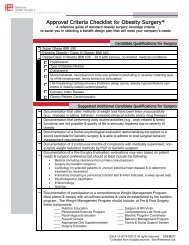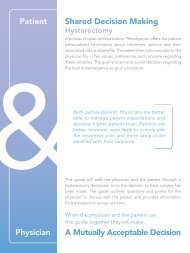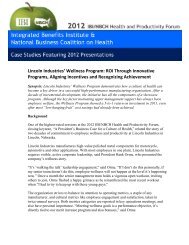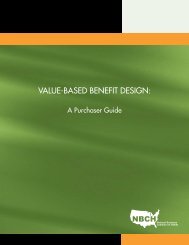Obesity/Weight Management Employer Survey and Interview Project
Obesity/Weight Management Employer Survey and Interview Project
Obesity/Weight Management Employer Survey and Interview Project
- No tags were found...
You also want an ePaper? Increase the reach of your titles
YUMPU automatically turns print PDFs into web optimized ePapers that Google loves.
75. Can you discuss why you feel there is a disconnectbetween the perceived need to address obesityas an important health issue <strong>and</strong> the lack ofaction(s) taken?As described above, the issue is personal to theemployee. Since we do not seem to have much of aproblem with our workforce, we do not see this issueas having a significant impact on our insurance costs orproductivity. Additionally, we have a diverse workforce<strong>and</strong> want to respect individual preferences <strong>and</strong> culturesas well as language.76. What do you think the main benefits oradvantages are for your employer if you were tohave a workplace obesity program?The potential to impact direct <strong>and</strong> indirect costs mightbe a factor. In the safety area, we do not have accessto information about benefit or claim costs that mightsuggest overweight/obesity is a cost issue or an areafor concern due to the conditions related to obesity. Wehave not seen this as an issue with our safety program.The CEO is engaged in the safety program <strong>and</strong> we havea strong commitment to safety. This is demonstratedby the ongoing evaluation program for safety thatprovides rewards to employees: 3 months withoutan accident, employees are provided with lunch bythe company at the worksite; 6 months without anaccident, employees are provided with a half day (4hours) of time off. Currently we have logged 3 millionhours with no accidents.Employees are encouraged to speak with coworkers ifthey see an unsafe work practice since peer influenceis very helpful in achieving our goals. We also have anannual meeting with Senior <strong>Management</strong> to report onsafety <strong>and</strong> our results. This is part of an annual 3 daytraining <strong>and</strong> sharing best practices meeting for all ourfacilities. At an annual employee meeting, issues withOSHA, training, etc. are presented <strong>and</strong> discussed withemployees. In addition, we have a training facility withvideo conference capability as well as individual <strong>and</strong>group training.We might benefit from an approach where we wouldstep back <strong>and</strong> look at the entire picture with theworkforce to address: is there a problem? We coulduse claims <strong>and</strong> other data to assess the picture withrespect to employees <strong>and</strong> families for such conditionsas heart health <strong>and</strong> diabetes along with any informationfrom health assessments or physical assessments. Thismight include a brief overview of how obesity relatesto other medical conditions. This would provide a morecomprehensive context for the discussion.77. From the potential sources of information, whatdo you use <strong>and</strong> why?Information sources include OSHA (occupational safety<strong>and</strong> health), NEPA (National Environmental Policy),CDC, NSC, specialty organizations such as those fordiabetes, <strong>and</strong> the Internet. Information is varied <strong>and</strong>aligns with specific issues such as safety or a healthcondition. Each separate view needs to be put togetherfor a total “picture.” Information from insurancecompanies might also be very helpful.We would welcome more information from CDC <strong>and</strong>NIOSH that would include:E Education for management,E Education for individuals (nonjudgmental),E Training for safety,E Procurement guidance that supports safety <strong>and</strong>effectiveness (ex. education about such items asstepladder weight restriction information),E Non regulatory approaches,E Individual responsibility <strong>and</strong> choice with educationto show the benefits for healthy choices withexamples with overweight <strong>and</strong> without, <strong>and</strong>E Recognize the differences in employer worksites<strong>and</strong> needs — “one size does not fit all”78. Very few employers are working with communitybasedorganizations around obesity <strong>and</strong> healthissues according to survey responses. Hasyour organization formed partnerships aroundemployee health generally <strong>and</strong>/or obesityspecifically?The company supports the United Way, AmericanRed Cross <strong>and</strong> other community organizations but hasnot engaged with any community partners for healthissues. If we were to do that, local physicians <strong>and</strong>hospital or clinic programs might be helpful.There is also a fitness center in the community thatprovides a discount for employees. The city has a walkarea that is a wildlife area near our worksite. Employeesare encouraged to walk or visit the area during lunch orbreaks.80National Business Coalition on Health









